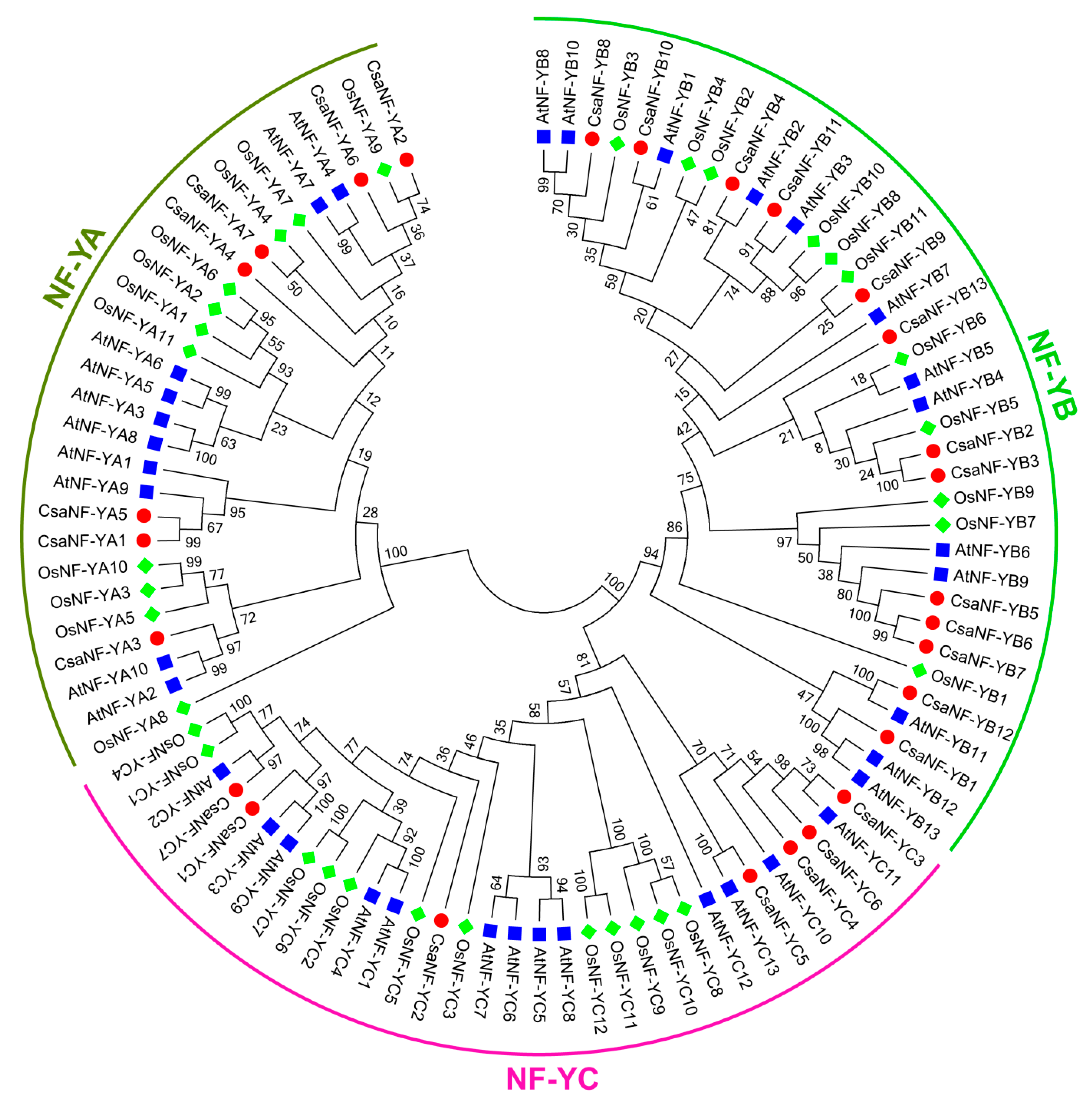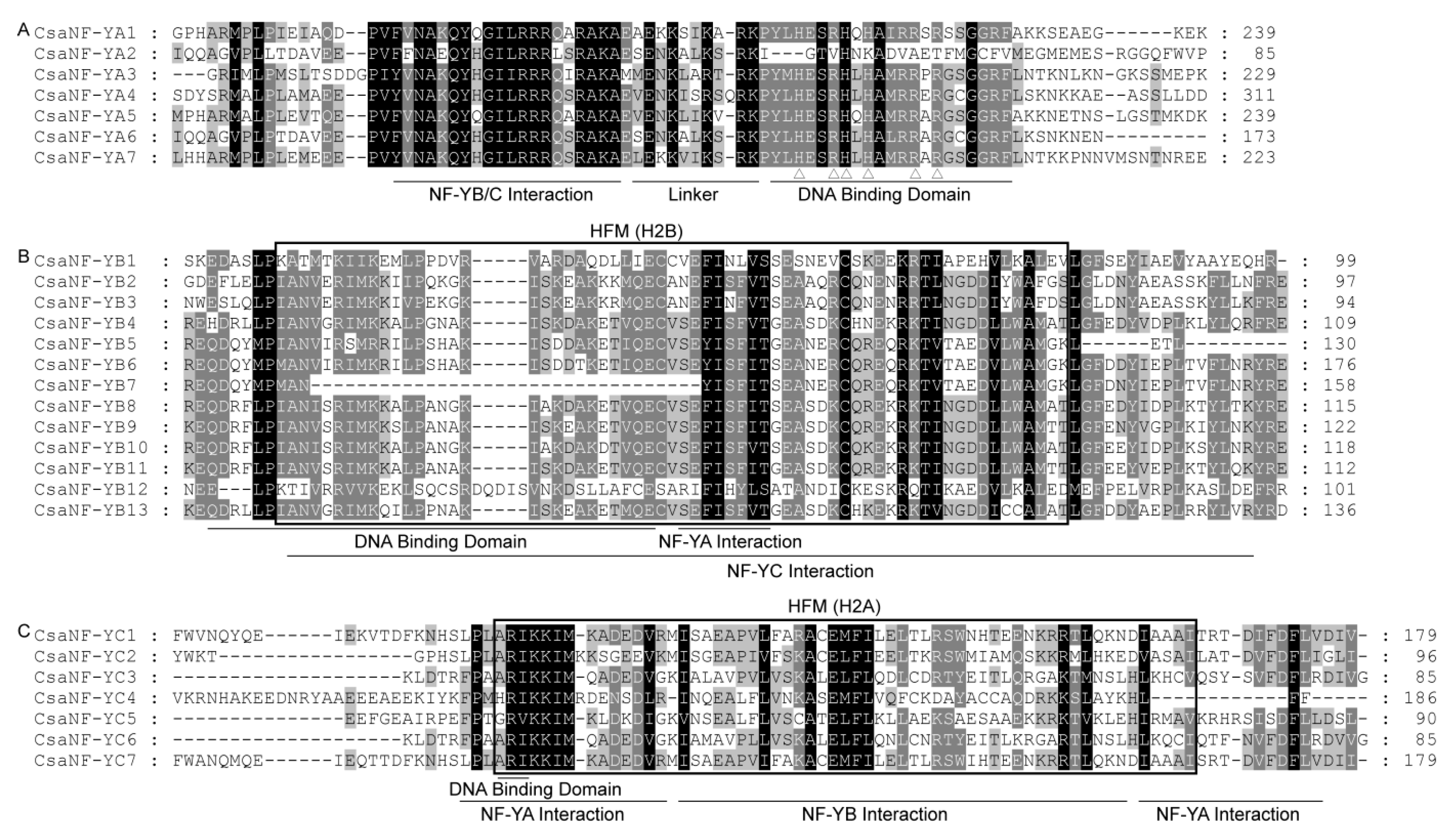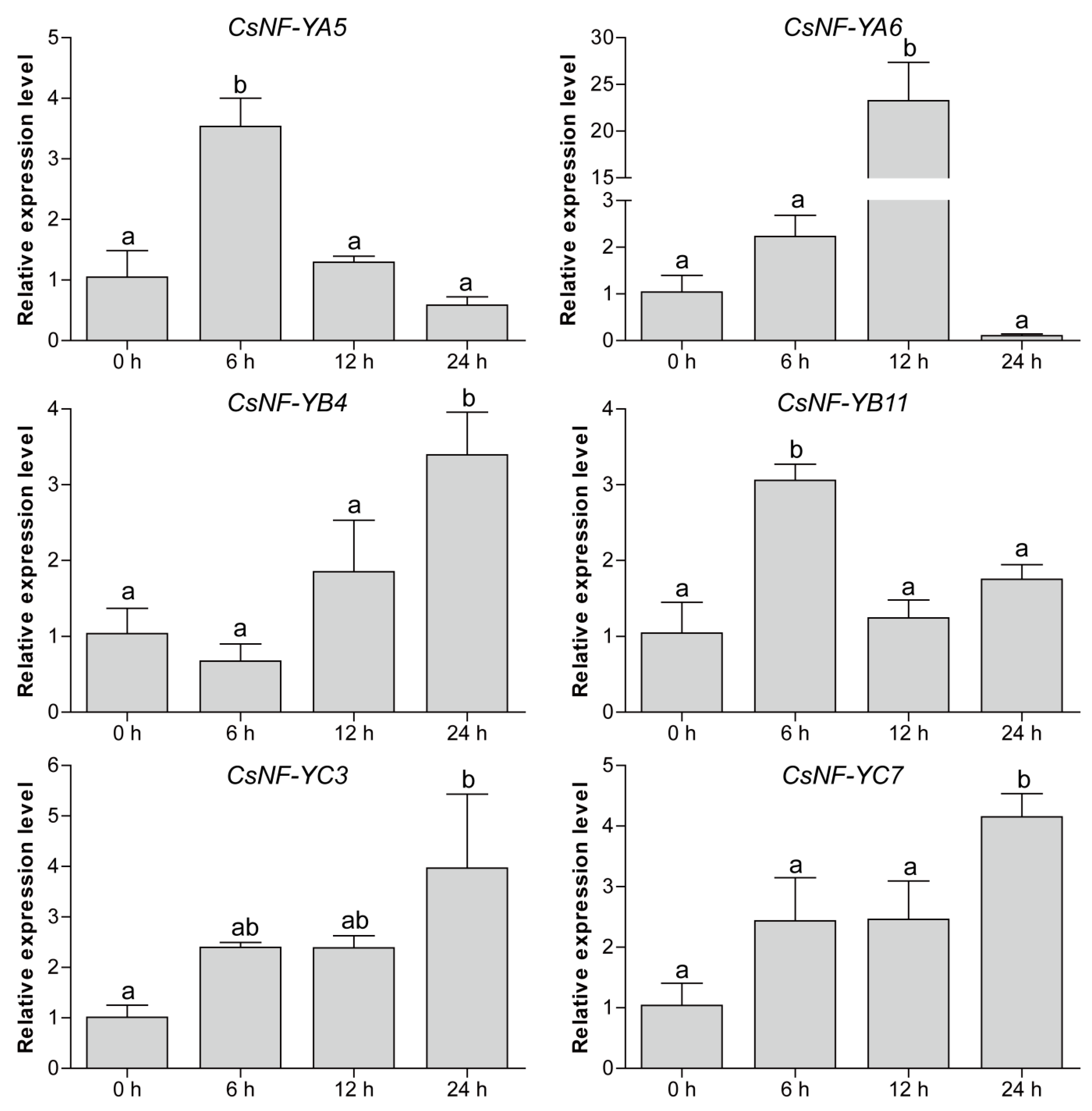In Silico Identification and Expression Analysis of Nuclear Factor Y (Nf-Y) Transcription Factors in Cucumber
Abstract
1. Introduction
2. Materials and Methods
2.1. Plant Materials and Abiotic Stress Treatments
2.2. Identification and Protein Property Analysis of NF-Y Members in Cucumber
2.3. Chromosomal Location, Sequence Alignment, and Phylogenetic Analysis
2.4. Gene Structure and Promoter Region Analysis
2.5. Expression Analysis of Cucumber NF-Y Genes With RNA-seq Data
2.6. RNA Extraction and Quantitative RT-PCR (qRT-PCR)
3. Results
3.1. Genome-Wide Identification of the NF-Y Gene Family in Cucumber
3.2. Phylogenetic Analysis, Chromosomal Location, and Gene Duplication of the NF-Y Gene Family
3.3. Conserved Domain Analysis of CsaNF-Y Proteins
3.4. Gene Structure Analysis of CsaNF-Y Genes
3.5. Bioinformatics Analysis of Putative CsaNF-Y Promoters
3.6. Expression Profiles of CsaNF-Y Genes in Various Tissues and Organs
3.7. Expression Patterns of CsaNF-Y Genes in Response To Various Abiotic Stresses
4. Discussion
5. Conclusions
Supplementary Materials
Author Contributions
Funding
Conflicts of Interest
References
- Laloum, T.; De Mita, S.; Gamas, P.; Baudin, M.; Niebel, A. CCAAT-box binding transcription factors in plants: Y so many? Trends Plant Sci. 2013, 18, 157–166. [Google Scholar] [CrossRef] [PubMed]
- Myers, Z.A.; Holt, B.F. NUCLEAR FACTOR-Y: Still complex after all these years? Curr. Opin. Plant. Biol. 2018, 45, 96–102. [Google Scholar] [CrossRef]
- Dolfini, D.; Zambelli, F.; Pavesi, G.; Mantovani, R. A perspective of promoter architecture from the CCAAT box. Cell Cycle 2009, 8, 4127–4137. [Google Scholar] [CrossRef] [PubMed]
- Petroni, K.; Kumimoto, R.W.; Gnesutta, N.; Calvenzani, V.; Fornari, M.; Tonelli, C.; Holt, B.F.; Mantovani, R. The promiscuous life of plant NUCLEAR FACTOR Y transcription factors. Plant. Cell 2012, 24, 4777–4792. [Google Scholar] [CrossRef] [PubMed]
- Zanetti, M.E.; Ripodas, C.; Niebel, A. Plant NF-Y transcription factors: Key players in plant-microbe interactions, root development and adaptation to stress. Biochim. Biophys. Acta. Gene Regul. Mech. 2017, 1860, 645–654. [Google Scholar] [CrossRef] [PubMed]
- Li, S.; Li, K.; Ju, Z.; Cao, D.; Fu, D.; Zhu, H.; Zhu, B.; Luo, Y. Genome-wide analysis of tomato NF-Y factors and their role in fruit ripening. Can. J. Plant Sci 2016, 17, 36. [Google Scholar] [CrossRef]
- Dolfini, D.; Gatta, R.; Mantovani, R. NF-Y and the transcriptional activation of CCAAT promoters. Crit. Rev. Biochem. Mol. Biol. 2012, 47, 29–49. [Google Scholar] [CrossRef]
- Li, X.Y.; Hooft van Huijsduijnen, R.; Mantovani, R.; Benoist, C.; Mathis, D. Intron-exon organization of the NF-Y genes. Tissue-specific splicing modifies an activation domain. J. Biol. Chem. 1992, 267, 8984–8990. [Google Scholar]
- Maity, S.N.; de Crombrugghe, B. Biochemical analysis of the B subunit of the heteromeric CCAAT-binding factor. A DNA-binding domain and a subunit interaction domain are specified by two separate segments. J. Biol. Chem. 1992, 267, 8286–8292. [Google Scholar]
- Siefers, N.; Dang, K.K.; Kumimoto, R.W.; Bynum, W.E.T.; Tayrose, G.; Holt, B.F. Tissue-specific expression patterns of Arabidopsis NF-Y transcription factors suggest potential for extensive combinatorial complexity. Plant Physiol. 2009, 149, 625–641. [Google Scholar] [CrossRef]
- Yang, W.; Lu, Z.; Xiong, Y.; Yao, J. Genome-wide identification and co-expression network analysis of the OsNF-Y gene family in rice. Crop J. 2017, 5, 21–31. [Google Scholar] [CrossRef]
- Panahi, B.; Mohammadi, S.A.; Ruzicka, K.; Abbasi Holaso, H.; Zare Mehrjerdi, M. Genome-wide identification and co-expression network analysis of nuclear factor-Y in barley revealed potential functions in salt stress. Physiol. Mol. Biol. Plants 2019, 25, 485–495. [Google Scholar] [CrossRef] [PubMed]
- Mai, Y.; Shui, L.; Huo, K.; Niu, J. Genome-wide characterization of the NUCLEAR FACTOR-Y (NF-Y) family in Citrus grandis identified CgNF-YB9 involved in the fructose and glucose accumulation. Genes Genomics 2019, 41, 1341–1355. [Google Scholar] [CrossRef] [PubMed]
- Li, M.; Li, G.; Liu, W.; Dong, X.; Zhang, A. Genome-wide analysis of the NF-Y gene family in peach (Prunus persica L.). BMC Genomics 2019, 20, 612. [Google Scholar] [CrossRef]
- Wang, Y.; Xu, W.; Chen, Z.; Han, B.; Haque, M.E.; Liu, A. Gene structure, expression pattern and interaction of Nuclear Factor-Y family in castor bean (Ricinus communis). Planta 2018, 247, 559–572. [Google Scholar] [CrossRef]
- Wang, P.; Zheng, Y.; Guo, Y.; Chen, X.; Sun, Y.; Yang, J.; Ye, N. Identification, expression, and putative target gene analysis of nuclear factor-Y (NF-Y) transcription factors in tea plant (Camellia sinensis). Planta 2019, 250, 1671–1686. [Google Scholar] [CrossRef]
- Maheshwari, P.; Kummari, D.; Palakolanu, S.R.; Nagasai Tejaswi, U.; Nagaraju, M.; Rajasheker, G.; Jawahar, G.; Jalaja, N.; Rathnagiri, P.; Kavi Kishor, P.B. Genome-wide identification and expression profile analysis of nuclear factor Y family genes in Sorghum bicolor L. (Moench). PLoS ONE 2019, 14, e0222203. [Google Scholar] [CrossRef]
- Yan, H.; Wu, F.; Jiang, G.; Xiao, L.; Li, Z.; Duan, X.; Jiang, Y. Genome-wide identification, characterization and expression analysis of NF-Y gene family in relation to fruit ripening in banana. Posthar. Biol. Tec. 2019, 151, 98–110. [Google Scholar] [CrossRef]
- He, X.; Liu, G.; Li, B.; Xie, Y.; Wei, Y.; Shang, S.; Tian, L.; Shi, H. Functional analysis of the heterotrimeric NF-Y transcription factor complex in cassava disease resistance. Ann. Bot. 2020, 124, 1185–1198. [Google Scholar] [CrossRef]
- Siriwardana, C.L.; Gnesutta, N.; Kumimoto, R.W.; Jones, D.S.; Myers, Z.A.; Mantovani, R.; Holt, B.F. NUCLEAR FACTOR Y, subunit A (NF-YA) proteins positively regulate flowering and act through FLOWERING LOCUS T. PLoS Genet. 2016, 12, e1006496. [Google Scholar] [CrossRef]
- Hwang, Y.H.; Kim, S.K.; Lee, K.C.; Chung, Y.S.; Lee, J.H.; Kim, J.K. Functional conservation of rice OsNF-YB/YC and Arabidopsis AtNF-YB/YC proteins in the regulation of flowering time. Plant Cell Rep. 2016, 35, 857–865. [Google Scholar] [CrossRef]
- Liu, X.; Hu, P.; Huang, M.; Tang, Y.; Li, Y.; Li, L.; Hou, X. The NF-YC-RGL2 module integrates GA and ABA signalling to regulate seed germination in Arabidopsis. Nat. Commun. 2016, 7, 12768. [Google Scholar] [CrossRef]
- Tang, Y.; Liu, X.; Liu, X.; Li, Y.; Wu, K.; Hou, X. Arabidopsis NF-YCs mediate the light-controlled hypocotyl elongation via modulating histone acetylation. Mol. Plant 2017, 10, 260–273. [Google Scholar] [CrossRef] [PubMed]
- Myers, Z.A.; Kumimoto, R.W.; Siriwardana, C.L.; Gayler, K.K.; Risinger, J.R.; Pezzetta, D.; Holt Iii, B.F. NUCLEAR FACTOR Y, Subunit C (NF-YC) transcription factors are positive regulators of photomorphogenesis in Arabidopsis thaliana. PLoS Genet. 2016, 12, e1006333. [Google Scholar] [CrossRef] [PubMed]
- Ballif, J.; Endo, S.; Kotani, M.; MacAdam, J.; Wu, Y. Over-expression of HAP3b enhances primary root elongation in Arabidopsis. Plant Physiol. Biochem. 2011, 49, 579–583. [Google Scholar] [CrossRef] [PubMed]
- Sorin, C.; Declerck, M.; Christ, A.; Blein, T.; Ma, L.; Lelandais-Briere, C.; Njo, M.F.; Beeckman, T.; Crespi, M.; Hartmann, C. A miR169 isoform regulates specific NF-YA targets and root architecture in Arabidopsis. New Phytol. 2014, 202, 1197–1211. [Google Scholar] [CrossRef]
- Xu, J.J.; Zhang, X.F.; Xue, H.W. Rice aleurone layer specific OsNF-YB1 regulates grain filling and endosperm development by interacting with an ERF transcription factor. J. Exp. Bot. 2016, 67, 6399–6411. [Google Scholar] [CrossRef]
- Bai, A.N.; Lu, X.D.; Li, D.Q.; Liu, J.X.; Liu, C.M. NF-YB1-regulated expression of sucrose transporters in aleurone facilitates sugar loading to rice endosperm. Cell Res. 2016, 26, 384–388. [Google Scholar] [CrossRef]
- Xiong, Y.; Ren, Y.; Li, W.; Wu, F.; Yang, W.; Huang, X.; Yao, J. NF-YC12 is a key multi-functional regulator of accumulation of seed storage substances in rice. J. Exp. Bot. 2019, 70, 3765–3780. [Google Scholar] [CrossRef]
- Su, H.; Cao, Y.; Ku, L.; Yao, W.; Cao, Y.; Ren, Z.; Dou, D.; Wang, H.; Ren, Z.; Liu, H.; et al. Dual functions of ZmNF-YA3 in photoperiod-dependent flowering and abiotic stress responses in maize. J. Exp. Bot. 2018, 69, 5177–5189. [Google Scholar] [CrossRef]
- Yang, M.; Zhao, Y.; Shi, S.; Du, X.; Gu, J.; Xiao, K. Wheat nuclear factor Y (NF-Y) B subfamily gene TaNF-YB3;l confers critical drought tolerance through modulation of the ABA-associated signaling pathway. Plant Cell Tiss. Organ Cult. 2017, 128, 97–111. [Google Scholar] [CrossRef]
- Zhou, Y.; Liu, S.; Yang, Z.; Yang, Y.; Jiang, L.; Hu, L. CsCAT3, a catalase gene from Cucumis sativus, confers resistance to a variety of stresses to Escherichia coli. Biotechnol. Biotec. Eq. 2017, 31, 886–896. [Google Scholar] [CrossRef]
- Yang, Y.; Ahammed, G.J.; Wan, C.; Liu, H.; Chen, R.; Zhou, Y. Comprehensive analysis of TIFY transcription factors and their expression profiles under jasmonic acid and abiotic stresses in watermelon. Int. J. Genom. 2019, 2019, 6813086. [Google Scholar] [CrossRef] [PubMed]
- Wang, Y.; Zhang, Y.; Zhou, R.; Dossa, K.; Yu, J.; Li, D.; Liu, A.; Mmadi, M.A.; Zhang, X.; You, J. Identification and characterization of the bZIP transcription factor family and its expression in response to abiotic stresses in sesame. PLoS ONE 2018, 13, e0200850. [Google Scholar] [CrossRef] [PubMed]
- Kumar, S.; Stecher, G.; Tamura, K. MEGA7: Molecular evolutionary genetics analysis version 7.0 for bigger datasets. Mol. Biol. Evol. 2016, 33, 1870–1874. [Google Scholar] [CrossRef]
- Li, Z.; Zhang, Z.; Yan, P.; Huang, S.; Fei, Z.; Lin, K. RNA-Seq improves annotation of protein-coding genes in the cucumber genome. BMC Genomics 2011, 12, 540. [Google Scholar] [CrossRef]
- Chen, C.; Chen, H.; He, Y.; Xia, R. TBtools, a Toolkit for Biologists integrating various biological data handling tools with a user-friendly interface. bioRxiv 2018, 289660. [Google Scholar]
- Zhou, Y.; Li, G.; Zhang, L.; Xu, J.; Hu, L.; Jiang, L.; Liu, S. Comprehensive genomic analysis and expression profiling of the BTB and TAZ (BT) genes in cucumber (Cucumis sativus L.). Czech J. Genet. Plant Breed. 2020, 56, 15–23. [Google Scholar] [CrossRef]
- Hackenberg, D.; Wu, Y.; Voigt, A.; Adams, R.; Schramm, P.; Grimm, B. Studies on differential nuclear translocation mechanism and assembly of the three subunits of the Arabidopsis thaliana transcription factor NF-Y. Mol. Plant 2012, 5, 876–888. [Google Scholar] [CrossRef]
- Lu, P.; Yu, S.; Zhu, N.; Chen, Y.R.; Zhou, B.; Pan, Y.; Tzeng, D.; Fabi, J.P.; Argyris, J.; Garcia-Mas, J.; et al. Genome encode analyses reveal the basis of convergent evolution of fleshy fruit ripening. Nat. Plants 2018, 4, 784–791. [Google Scholar] [CrossRef]
- Feng, Z.J.; He, G.H.; Zheng, W.J.; Lu, P.P.; Chen, M.; Gong, Y.M.; Ma, Y.Z.; Xu, Z.S. Foxtail millet NF-Y families: Genome-wide survey and evolution analyses identified two functional genes important in abiotic stresses. Front. Plant Sci. 2015, 6, 1142. [Google Scholar] [CrossRef] [PubMed]
- Quan, S.; Niu, J.; Zhou, L.; Xu, H.; Ma, L.; Qin, Y. Identification and characterization of NF-Y gene family in walnut (Juglans regia L.). BMC Plant Biol. 2018, 18, 255. [Google Scholar] [CrossRef] [PubMed]
- Chu, H.D.; Nguyen, K.H.; Watanabe, Y.; Le, D.T.; Pham, T.L.T.; Mochida, K.; Tran, L.P. Identification, structural characterization and gene expression analysis of members of the Nuclear Factor-Y family in chickpea (Cicer arietinum L.) under dehydration and abscisic acid treatments. Int. J. Mol. Sci. 2018, 19, 3290. [Google Scholar] [CrossRef] [PubMed]
- Kumimoto, R.W.; Adam, L.; Hymus, G.J.; Repetti, P.P.; Reuber, T.L.; Marion, C.M.; Hempel, F.D.; Ratcliffe, O.J. The Nuclear Factor Y subunits NF-YB2 and NF-YB3 play additive roles in the promotion of flowering by inductive long-day photoperiods in Arabidopsis. Planta 2008, 228, 709–723. [Google Scholar] [CrossRef]
- Kumimoto, R.W.; Zhang, Y.; Siefers, N.; Holt, B.F. NF-YC3, NF-YC4 and NF-YC9 are required for CONSTANS-mediated, photoperiod-dependent flowering in Arabidopsis thaliana. Plant J. 2010, 63, 379–391. [Google Scholar] [CrossRef] [PubMed]
- Gnesutta, N.; Chiara, M.; Bernardini, A.; Balestra, M.; Horner, D.; Mantovani, R. The plant NF-Y DNA matrix in vitro and in vivo. Plants 2019, 8, 406. [Google Scholar] [CrossRef]
- Zhang, T.; Zhang, D.; Liu, Y.; Luo, C.; Zhou, Y.; Zhang, L. Overexpression of a NF-YB3 transcription factor from Picea wilsonii confers tolerance to salinity and drought stress in transformed Arabidopsis thaliana. Plant Physiol. Biochem. 2015, 94, 153–164. [Google Scholar] [CrossRef]
- Chen, M.; Zhao, Y.; Zhuo, C.; Lu, S.; Guo, Z. Overexpression of a NF-YC transcription factor from bermudagrass confers tolerance to drought and salinity in transgenic rice. Plant Biotechnol. J. 2015, 13, 482–491. [Google Scholar] [CrossRef]
- Wu, X.; Shi, H.; Guo, Z. Overexpression of a NF-YC gene results in enhanced drought and salt tolerance in transgenic seashore paspalum. Front. Plant Sci. 2018, 9, 1355. [Google Scholar] [CrossRef]
- Sato, H.; Suzuki, T.; Takahashi, F.; Shinozaki, K.; Yamaguchi-Shinozaki, K. NF-YB2 and NF-YB3 have functionally diverged and differentially induce drought and heat stress-specific genes. Plant Physiol. 2019, 180, 1677–1690. [Google Scholar] [CrossRef]
- Ma, X.; Li, C.; Wang, M. Wheat NF-YA10 functions independently in salinity and drought stress. Bioengineered 2015, 6, 245–247. [Google Scholar] [CrossRef] [PubMed]






| Nomenclature | Locus | Chromosomal Position | gDNA (bp) | CDS (bp) | Protein | |||
|---|---|---|---|---|---|---|---|---|
| Length (aa) | MW (KDa) | pI | GRAVY | |||||
| CsaNF-YA1 | Csa1G613580 | Chr1: 24112521–24117512 | 3199 | 810 | 269 | 29.52 | 6.56 | −0.984 |
| CsaNF−YA2 | Csa3G644810 | Chr3: 25263223–25264735 | 1513 | 444 | 147 | 16.91 | 9.00 | −0.122 |
| CsaNF-YA3 | Csa3G782710 | Chr3: 30348958–30352913 | 3395 | 975 | 324 | 35.46 | 9.40 | −0.436 |
| CsaNF-YA4 | Csa4G159320 | Chr4: 8340821–8346110 | 5290 | 1035 | 344 | 38.98 | 8.63 | −0.489 |
| CsaNF-YA5 | Csa6G439960 | Chr6: 20632195–20637169 | 3212 | 1026 | 341 | 37.10 | 6.53 | −0.895 |
| CsaNF-YA6 | Csa6G525440 | Chr6: 28505741–28509554 | 3814 | 609 | 202 | 22.53 | 8.58 | −1.032 |
| CsaNF-YA7 | Csa7G428130 | Chr7: 16427189–16430567 | 2325 | 957 | 318 | 35.57 | 6.96 | −0.733 |
| CsaNF-YB1 | Csa1G015800 | Chr1: 2159806–2163445 | 3332 | 471 | 156 | 17.47 | 4.68 | −0.547 |
| CsaNF-YB2 | Csa1G569510 | Chr1: 21018573–21018944 | 372 | 372 | 123 | 14.11 | 6.10 | −0.903 |
| CsaNF-YB3 | Csa1G569530 | Chr1: 21023622–21023978 | 357 | 357 | 118 | 13.63 | 5.29 | −0.815 |
| CsaNF-YB4 | Csa3G047800 | Chr3: 3332696–3333441 | 555 | 555 | 184 | 19.54 | 5.46 | −0.630 |
| CsaNF-YB5 | Csa3G048940 | Chr3: 3452386–3453255 | 870 | 411 | 136 | 15.10 | 5.51 | −0.680 |
| CsaNF-YB6 | Csa3G049440 | Chr3: 3458401–3459120 | 720 | 720 | 239 | 26.50 | 5.29 | −0.495 |
| CsaNF-YB7 | Csa3G055940 | Chr3: 3469618–3470370 | 753 | 666 | 221 | 24.78 | 5.04 | −0.533 |
| CsaNF-YB8 | Csa3G736780 | Chr3: 28408903–28412596 | 3242 | 522 | 173 | 18.76 | 6.09 | −0.758 |
| CsaNF-YB9 | Csa4G037610 | Chr4: 3160771–3161568 | 722 | 678 | 225 | 24.73 | 7.76 | −0.638 |
| CsaNF-YB10 | Csa5G175930 | Chr5: 7498740–7502620 | 3881 | 528 | 175 | 19.17 | 5.26 | −0.709 |
| CsaNF-YB11 | Csa6G112490 | Chr6: 7775649–7777337 | 925 | 606 | 201 | 20.62 | 6.31 | −0.636 |
| CsaNF-YB12 | Csa6G425700 | Chr6: 19919807–19922480 | 2190 | 483 | 160 | 18.05 | 4.77 | −1.087 |
| CsaNF-YB13 | Csa7G395250 | Chr7: 15134980–15135499 | 520 | 483 | 160 | 17.37 | 5.03 | −0.781 |
| CsaNF-YC1 | Csa1G570150 | Chr1: 21086208–21089499 | 1214 | 780 | 259 | 28.70 | 5.89 | −0.518 |
| CsaNF-YC2 | Csa4G049050 | Chr4: 3878004–3878711 | 513 | 360 | 119 | 13.09 | 7.76 | 0.035 |
| CsaNF-YC3 | Csa5G583350 | Chr5: 20754210–20758105 | 3896 | 852 | 283 | 31.66 | 5.14 | −0.918 |
| CsaNF-YC4 | Csa6G294440 | Chr6: 14150180–14153107 | 1843 | 573 | 190 | 21.31 | 9.53 | −1.115 |
| CsaNF-YC5 | Csa6G365140 | Chr6: 16501105–16501524 | 420 | 420 | 139 | 15.72 | 9.01 | −0.658 |
| CsaNF-YC6 | Csa6G426970 | Chr6: 20154306–20158203 | 3898 | 843 | 280 | 31.23 | 4.90 | −0.816 |
| CsaNF-YC7 | Csa7G051420 | Chr7: 3270343–3272852 | 2510 | 801 | 266 | 29.96 | 5.96 | −0.705 |
© 2020 by the authors. Licensee MDPI, Basel, Switzerland. This article is an open access article distributed under the terms and conditions of the Creative Commons Attribution (CC BY) license (http://creativecommons.org/licenses/by/4.0/).
Share and Cite
Chen, L.; Zhou, Y.; Lai, W.; Hu, L.; Jiang, L.; Liu, S. In Silico Identification and Expression Analysis of Nuclear Factor Y (Nf-Y) Transcription Factors in Cucumber. Agronomy 2020, 10, 236. https://doi.org/10.3390/agronomy10020236
Chen L, Zhou Y, Lai W, Hu L, Jiang L, Liu S. In Silico Identification and Expression Analysis of Nuclear Factor Y (Nf-Y) Transcription Factors in Cucumber. Agronomy. 2020; 10(2):236. https://doi.org/10.3390/agronomy10020236
Chicago/Turabian StyleChen, Lianghai, Yong Zhou, Wei Lai, Lifang Hu, Lunwei Jiang, and Shiqiang Liu. 2020. "In Silico Identification and Expression Analysis of Nuclear Factor Y (Nf-Y) Transcription Factors in Cucumber" Agronomy 10, no. 2: 236. https://doi.org/10.3390/agronomy10020236
APA StyleChen, L., Zhou, Y., Lai, W., Hu, L., Jiang, L., & Liu, S. (2020). In Silico Identification and Expression Analysis of Nuclear Factor Y (Nf-Y) Transcription Factors in Cucumber. Agronomy, 10(2), 236. https://doi.org/10.3390/agronomy10020236






